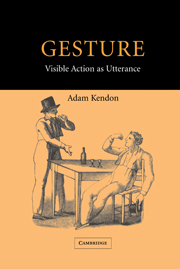Book contents
- Frontmatter
- Contents
- Acknowledgments
- 1 The domain of gesture
- 2 Visible action as gesture
- 3 Western interest in gesture from Classical Antiquity to the eighteenth century
- 4 Four contributions from the nineteenth century: Andrea de Jorio, Edward Tylor, Garrick Mallery and Wilhelm Wundt
- 5 Gesture studies in the twentieth century: recession and return
- 6 Classifying gestures
- 7 Gesture units, gesture phrases and speech
- 8 Deployments of gesture in the utterance
- 9 Gesture and speech in semantic interaction
- 10 Gesture and referential meaning
- 11 On pointing
- 12 Gestures of ‘precision grip’: topic, comment and question markers
- 13 Two gesture families of the open hand
- 14 Gesture without speech: the emergence of kinesic codes
- 15 ‘Gesture’ and ‘sign’ on common ground
- 16 Gesture, culture and the communication economy
- 17 The status of gesture
- Appendix I Transcription conventions
- Appendix II The recordings
- References
- Index
12 - Gestures of ‘precision grip’: topic, comment and question markers
Published online by Cambridge University Press: 05 February 2015
- Frontmatter
- Contents
- Acknowledgments
- 1 The domain of gesture
- 2 Visible action as gesture
- 3 Western interest in gesture from Classical Antiquity to the eighteenth century
- 4 Four contributions from the nineteenth century: Andrea de Jorio, Edward Tylor, Garrick Mallery and Wilhelm Wundt
- 5 Gesture studies in the twentieth century: recession and return
- 6 Classifying gestures
- 7 Gesture units, gesture phrases and speech
- 8 Deployments of gesture in the utterance
- 9 Gesture and speech in semantic interaction
- 10 Gesture and referential meaning
- 11 On pointing
- 12 Gestures of ‘precision grip’: topic, comment and question markers
- 13 Two gesture families of the open hand
- 14 Gesture without speech: the emergence of kinesic codes
- 15 ‘Gesture’ and ‘sign’ on common ground
- 16 Gesture, culture and the communication economy
- 17 The status of gesture
- Appendix I Transcription conventions
- Appendix II The recordings
- References
- Index
Summary
In the last three chapters we have explored the ways in which gesture can add to the propositional meaning of the utterance of which it is a part. However, as we stated in Chapter 9, speakers also use gestures as part of the way in which they ‘do things’ with utterances. A speaker always produces an utterance to achieve something. As a participant in a conversation I may complain, evaluate, disagree, refuse, plead, assert, maintain something in opposition, mock, attack, retreat, show deference, ignore, exhibit scepticism, give an honest answer, ask, and many other things. As has long been noted, gesture often plays an important part in carrying out such actions. Indeed, as we shall see, there are gestures that appear to be specialized as actions which, in their very performance, can constitute a particular move or ‘speech act’.
As explained in Chapter 9, the functions gestures have as they contribute to or constitute the acts or moves accomplished by utterances are referred to as pragmatic functions. In the terminology proposed, gestures which show what sort of a move or speech act a speaker is engaging in are said to have performative functions. Gestures are said to have modal functions if they seem to operate on a given unit of verbal discourse and show how it is to be interpreted. Gestures may serve parsing functions when they contribute to the marking of various aspects of the structure of spoken discourse.
- Type
- Chapter
- Information
- GestureVisible Action as Utterance, pp. 225 - 247Publisher: Cambridge University PressPrint publication year: 2004

